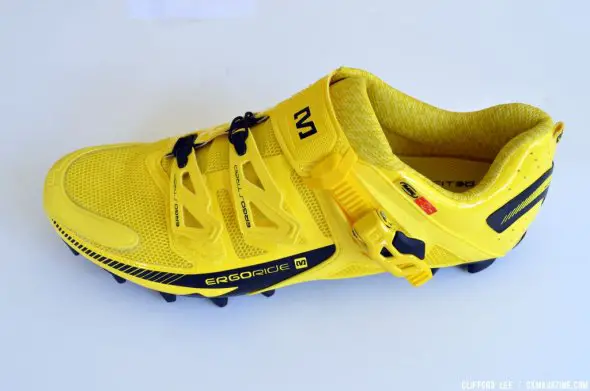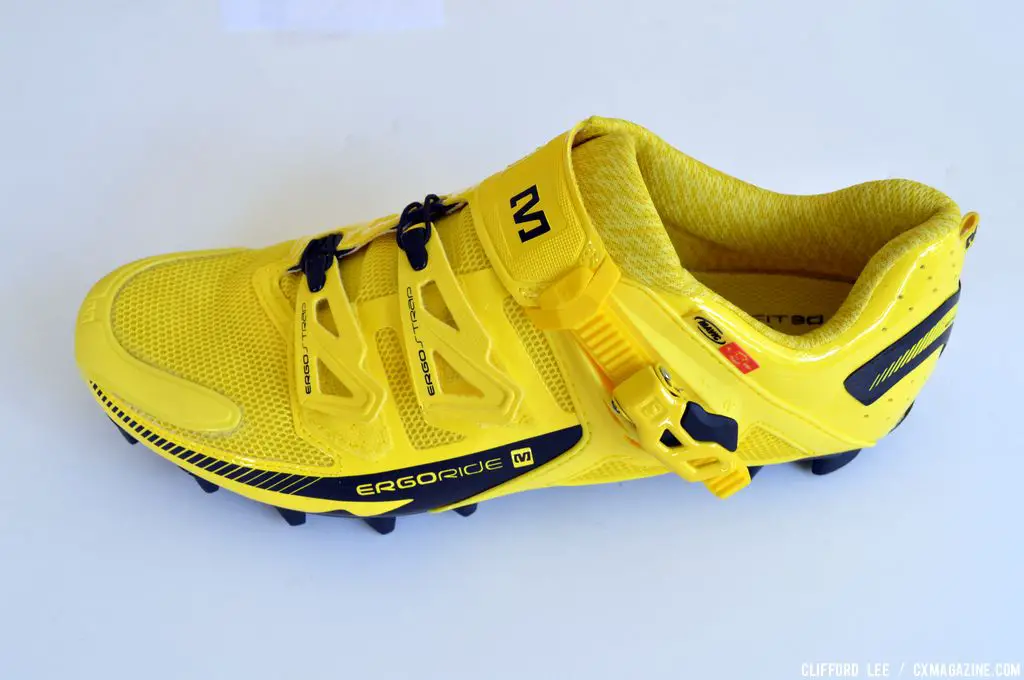
Mavic Fury shoe in iconic yellow, a top of the line cross country shoe with a stiff carbon sole. © Clifford Lee
A year ago, Mavic and Time announced a collaboration between the two French companies that would strengthen product development for both of them. Out of that collaboration is the introduction of the Mavic Crossmax, Crossroc, and Crossride pedals for mountain biking and, of course, cyclocross. Mavic sent a pair of the Crossmax SL pedals for review and close inspection reveals this to be a rebranded Time ATAC pedal with a Mavic SSC (Special Service Course) label. There is no Time labeling, but ATAC is molded into the pedal body, just as with the Time Atac XC8 version.
I have used Time pedals for more than a decade and it seems little has changed to this successful, durable, copied design. The new version has lost some weight, mainly by shrinking the bail and spring assembly, so pedal surface area could be maintained for shoe contact. However, that was always the problem with Time pedals: The bails sat higher than most shoe treads and therefore the shoe pedal interface was only on the bail, denting the shoe sole and causing a less stable, rocking interface. Eggbeaters have the same problem and Crankbrothers even sells “sole savers,” a metal plate that mounts under the cleat to remedy the sole denting problem. It doesn’t eliminate the rocking issue though, so I moved from the Time design to Look Quartz which relied on the patient setup and cleat shimming to yield a stable connection with the shoe tread.
The Time/Mavic collaboration led to the Mavic mountain shoe with an ATAC (Automatic Tension Adjustment Concept) pedal. We obtained a sample of the Mavic Fury shoe in iconic yellow, a top of the line cross country shoe with a stiff carbon sole. Aside from the loud yellow color that I really like, it is available in a more subdued black colorway. The Fury has the typical ratchet buckle at the ankle, but the release lever needs to be lifted rather than depressed, a feature I like since I’ve had my ratchet release bumped during racing leading to the loosening of my shoe, and this prevents that. The two lower closures are laces combined with a hook and loop fastener—a bit gimmicky, but perhaps allows easier adjustability. The upper is mesh and quite comfortable with an abbreviated toe bumper to keep the shoe light. It’s a good shoe for a medium volume foot.
The sole of the shoe is the biggest difference for a top end shoe: there is more rubber than typical for a light cross country shoe. The lugs are of a sticky rubber and are deeper than typical, the carbon area is reinforced by a hard composite to prevent sole denting, but most important, when paired with the Mavic Crossmax pedal, the sole lugs actually contact the pedal body to yield an interface that is similar to the old Look Quartz that I liked so much. That means less pressure on the bails, less denting of the sole, and a more stable platform for power transfer. The Fury also has rubber on the arch portion of the sole, so riding unclipped, or jamming on the pedal on a start or remount is more assured in case you don’t clip in immediately.
I’m impressed by this combination. I found the Fury shoe to be attractive and comfortable. The toe box is on the medium to narrow side, so best for lower volume feet unless you size up. The yellow will definitely show mud more easily, but as I mentioned, I like the flashiness. The Crossmax pedal is a proven mud-shedding, easy in, easy out design, and now mated to the Mavic shoe, a more stable platform for efficiency.
Mavic Crossmax SL pedal
- 288 grams/pair, steel axle
- MSRP: $250
Mavic Fury
- 394 grams/shoe (size: 43.5)
- MSRP: $325
- More info: mavic.com
Clifford Lee
Latest posts by Clifford Lee (see all)
- Ridden and Reviewed: Kona Ouroboros Supreme Gravel/Adventure Bike - January 31, 2025
- The First Legendary Drop Bar Mountain Bike Racer: Jacquie Phelan - December 21, 2024
- Reviewed: Felt Breed Advanced GRX 820 Gravel Bike - September 30, 2024



































